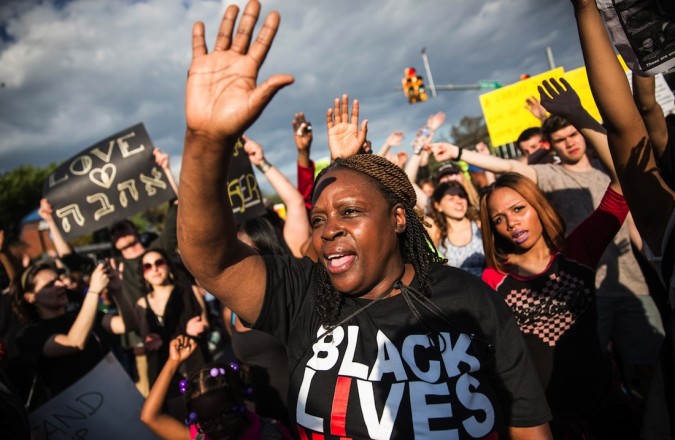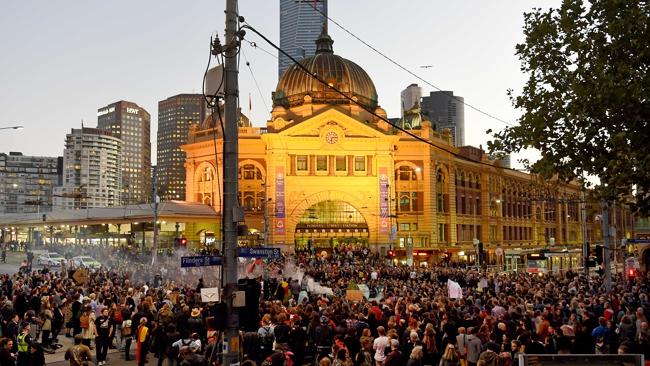
As our readings by Vine Deloria Jr. have shown us, “A democratic society is always up tight about real rebellions because its very operating premise is that rebellions are nice. When rebellions turn out to be not so nice, panic prevails.” (Deloria 98). Although written in the 60s, recent protests against state violence in New York City, Baltimore, and Australia have demonstrated that Deloria’s point remains salient. From this realization, the question looms: how are we to build resistance movements that are able to pierce through the “panic ceiling” that has lead to reporters calling black protesters “thugs” and aboriginal Australian protesters “selfish?” One proposed answer to this problem that has emerged in recent years is the possibility of going global and building transnational networks of activism, resistance, and alternative media representation.
One major obstacle to achieving transnational solidarity, however, has been the stark divide between anti-racist activism and anti-colonial activism within the United States. The lack of solidarity between black and Native American activist circles is not only confusing, but it makes certain “causes” wholly incoherent. The mutual support between anti-racist activists in the US and Palestinian activists, for example, is complicated by not including Native American activists and their causes. How can US-based activists fight for the self-determination of the Palestinian people and not do the same for the indigenous peoples whose land they are occupying?
Andrea Smith, a Cherokee feminist scholar, suggests that the gap between decolonization and anti-racism in the United States is itself the result of anti-blackness. By this, she suggests that
the colonization of Africa must disappear so that Africa can appear as ontologically colonized. According to Justice Daniel [the judge who made the famous Dred Scott decision in 1857], since only “nations” can be colonized, nations in Africa can never have existed. It is only through the disavowal of colonization that Black peoples can be ontologically relegated to the status of property. Within the Dred Scott decision, Native peoples by contrast, are situated as potential citizens. Native peoples are described as “free” people, albeit “uncivilized.” While because of their child-like primitive state, they are not worthy of citizenship at the moment, they may eventually become citizens if they were to renounce their relationship to their Native nation and demonstrate the “maturity” required to become a citizen. (Smith)
Smith further suggests that this “disappearanc e” of the colonization of Africa relegates black Americans to the status of “internal property” of the United States–making anti-racism a domestic movement “that cannot challenge the settler state itself” and, thus, further reifies the colonization and genocide of Native Americans.

If we are to take Smith’s claims seriously, reframing anti-racism within the broader framework of global decolonization may be a more fruitful way of conceptualizing state violence within the United States and abroad. This is not to say that Native American and black activists should unite under the same cause per se but, rather, understand that remaining entirely separate movements only furthers anti-blackness and colonization. The state violence we have seen against the black residents of Baltimore does not exist in a vacuum vis-à-vis the closure of remote aboriginal communities in Australia or the high rates of teen suicide in Pine Ridge. These pockets of violence are certainly not the same, but they are undoubtedly tied to processes of colonization and violence that uphold modern nation states like the United States and Australia. This drastic unification of anti-violence movements around the world may sound far-fetched, but I’ve found similar statements on Facebook made by tribal elders in Australia, in a speech made by a community activist in Baltimore, and now I’m saying it: it’s time to get past boundaries meant to divide communities, like anti-blackness, and realize we have more to gain by committing to decolonization on a global scale than we have to lose (and have already lost).
Further Readings:
https://decolonization.wordpress.com/2014/06/20/the-colonialism-that-is-settled-and-the-colonialism-that-never-happened/
http://www.colorlines.com/articles/racism-core-native-teen-suicides-pine-ridge
http://www.theatlantic.com/politics/archive/2015/04/ta-nehisi-coates-johns-hopkins-baltimore/391904/
http://www.theguardian.com/commentisfree/2015/apr/22/by-evicting-the-homelands-australia-has-again-declared-war-on-indigenous-people
Images:
(1) Andrew Burton/Getty Images
(2) Jake Nowakowski/Herald Sun
